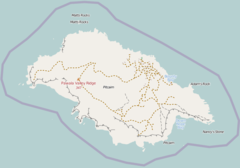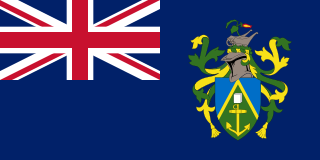
The Pitcairn Islands, officially Pitcairn, Henderson, Ducie and Oeno Islands, are a group of four volcanic islands in the southern Pacific Ocean that form the sole British Overseas Territory in the Pacific Ocean. The four islands—Pitcairn, Henderson, Ducie and Oeno—are scattered across several hundred miles of ocean and have a combined land area of about 18 square miles (47 km2). Henderson Island accounts for 86% of the land area, but only Pitcairn Island is inhabited. The inhabited islands nearest to the Pitcairn Islands are Mangareva, 688 km to the west, as well as Easter Island, 1,929 km to the east.

The Pitcairn Islands are a group of four islands in the south Pacific Ocean: the group comprises Pitcairn Island, Henderson Island, and two coral atolls, Oeno Island and Ducie Island.
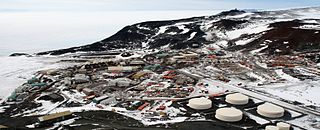
McMurdo Station is an American Antarctic research station on the southern tip of Ross Island, which is in the New Zealand–claimed Ross Dependency on the shore of McMurdo Sound in Antarctica. It is operated by the United States through the United States Antarctic Program (USAP), a branch of the National Science Foundation. The station is the largest community in Antarctica, capable of supporting up to 1,500 residents, and serves as one of three year-round United States Antarctic science facilities. All personnel and cargo going to or coming from Amundsen–Scott South Pole Station first pass through McMurdo. McMurdo Station continues to operate as the hub for American activities on the Antarctic continent. By road, McMurdo is 3 kilometres (1.9 mi) from New Zealand's smaller Scott Base.

Oeno Island or Holiday Island is an uninhabited coral atoll in the South Pacific Ocean, part of the Pitcairn Islands overseas territory. It is part of the Pitcairn Island Group, together with Pitcairn, Henderson and Ducie islands.

Ducie Island is an uninhabited atoll in the Pitcairn Islands group, which also includes Pitcairn, Henderson and Oeno islands. Ducie lies east of Pitcairn Island, and east of Henderson Island, and has a total area of 1.5 square miles (3.9 km2), which includes the lagoon. It is 1.5 miles (2.4 km) long, measured northeast to southwest, and about 1 mile (1.6 km) wide. The island is composed of four islets: Acadia, Pandora, Westward and Edwards.

Bounty Bay is an embayment of the Pacific Ocean into Pitcairn Island. It is named after the Bounty, a British naval vessel whose eighteenth-century mutiny was immortalized in the novel Mutiny on the Bounty, and the numerous subsequent motion pictures made of it. The mutineers sailed the Bounty to Pitcairn Island and destroyed it by fire in the bay. Current Pitcairn Islanders are largely patrilineal descendants of the mutineers and their Tahitian wives, as exhibited by some of their surnames.
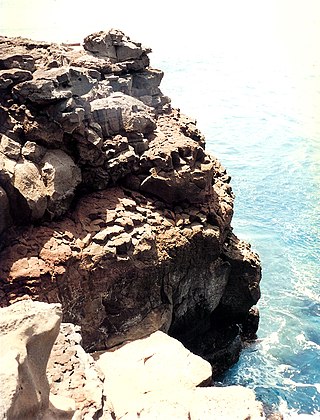
Ka Lae, also known as South Point, is the southernmost point of the Big Island of Hawaii and of the 50 United States. The Ka Lae area is registered as a National Historic Landmark District under the name South Point Complex. The area is also known for its strong ocean currents and winds and is the home of a wind farm.

Severe Tropical Cyclone Olaf was the sixth cyclone to form in the Southwest Pacific Ocean during the 2004–05 South Pacific cyclone season. Olaf was also one of three simultaneous cyclones to form during the 2004–05 season, forming 21 hours after Cyclone Nancy formed to the east. A powerful Category 5 cyclone, Olaf stuck American Samoa causing heavy damage although exact estimates are unknown. Despite the damage, there were no reported deaths or injuries from the cyclone. Olaf was third South Pacific cyclone to hit the Cook Islands during the 2004–05 season, and Cyclone Percy would later affect the already devastated archipelago less than 2 weeks later.

The 1997–98 South Pacific cyclone season was the most active South Pacific tropical cyclone season on record, with 16 tropical cyclones occurring within the South Pacific basin between 160°E and 120°W. The season started earlier than normal with 3 systems developing before the official start of the season on November 1, 1997, while the final system of the season dissipated on May 3, 1998, after the season had officially ended on April 30. During the season 50 people died as a result of tropical cyclones, with the deadliest being Cyclone Martin with 27 known deaths. The strongest tropical cyclones during the season were Cyclone Ron and Cyclone Susan as both were estimated to have minimum pressures of 900 hectopascals (26.6 inHg), and were the most intense tropical cyclones on record in the South Pacific Ocean until Cyclone Zoe in 2002–03. After the season ended, 11 names had their names either removed or retired from the lists of names, after they caused significant impacts to South Pacific islands.
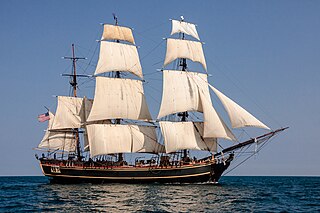
HMS Bounty, also known as HM Armed Vessel Bounty, was a British merchant ship that the Royal Navy purchased in 1787 for a botanical mission. The ship was sent to the South Pacific Ocean under the command of William Bligh to acquire breadfruit plants and transport them to the British West Indies. That mission was never completed owing to a 1789 mutiny led by acting lieutenant Fletcher Christian, an incident now popularly known as the Mutiny on the Bounty. The mutineers later burned Bounty while she was moored at Pitcairn Island in the Southern Pacific Ocean in 1790. An American adventurer helped land several remains of Bounty in 1957.

The 1989–90 South Pacific cyclone season was a below-average season with only five tropical cyclones occurring within the South Pacific to the east of 160°E. The season officially ran from November 1, 1989, to April 30, 1990, with the first disturbance of the season forming on November 8 and the last disturbance dissipating on March 19. This is the period of the year when most tropical cyclones form within the South Pacific Ocean.

Pitcairn Island Museum is a museum in Pitcairn Island, a British Overseas Territory in the southern Pacific Ocean. Established in 2005, the museum's collection includes archaeological material from the earliest Polynesian settlers, as well as artefacts from HMS Bounty.
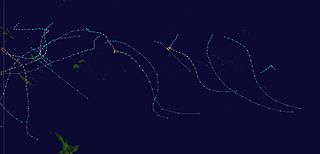
The 1991–92 South Pacific cyclone season was an above average tropical cyclone season, with eleven tropical cyclones occurring within the South Pacific basin between 160°E and 120°W. The first tropical cyclone of the season was first noted on November 13, 1991, while the last tropical cyclone dissipated on May 2, 1992. During the season at least 21 people were killed by tropical cyclones, while Tropical Cyclones Cliff and Innis were the only tropical cyclones not to cause any damage to any country in the Southern Pacific.

The 1982–83 South Pacific cyclone season was one of the most active and longest South Pacific tropical cyclone seasons on record, with 16 tropical cyclones occurring within the South Pacific basin between 160°E and 120°W. During the season tropical cyclones were monitored by the meteorological services of Australia, Fiji, French Polynesia and New Zealand. The United States Armed Forces through the Joint Typhoon Warning Center (JTWC) and Naval Pacific Meteorology and Oceanography Center (NPMOC), also monitored the basin and issued unofficial warnings for American interests. The first tropical cyclone of the season developed a day before the season officially began on October 30, while the last tropical cyclone of the season dissipated on May 16. Most of the activity during the season occurred within the central and eastern parts of the basin with French Polynesia affected by several systems.
Down Rope is a coastal area on the southeast coast of Pitcairn Island in the south Pacific, to the east of the Aute Valley and north of Break Jim Hip, it lies on the eastern side of an inlet and contains large petroglyphs on the rock face, testament to the Polynesian settlers of centuries ago. It is described as "a steep cliff located on the southern coast south of Ned Young's Ground, and west of St Paul's Point. At its foot, despite its perilous descent, is a popular picnic area and Pitcairn's only beach." The descent from the cliff top is said to be "spine chilling". There is anchorage at Down Rope and ignimbrite is also found in the vicinity.
Nancy Stone is a rock off the southeast coast of Pitcairn Island in the south Pacific. It is located off the coast between St Paul's Point and Down Rope. It is said to be "Named for the English name of Toofaiti, the consort of Tararo who was taken by mutineer John Williams, the act that initiated the massacre of most of the men of the island."

Severe Tropical Cyclone Martin was the deadliest tropical cyclone of the 1997–98 South Pacific cyclone season. The system was first noted as a weak tropical disturbance on October 27, to the north of the Northern Cook Islands. Over the next few days atmospheric convection surrounding the system remained disorganized, as it moved towards the southwest and was affected by strong upper-level north-easterly winds and moderate to strong vertical wind shear. The system was subsequently named Martin during October 31, after it had rapidly developed further and shown a marked improvement organization.

The 2018–19 South Pacific cyclone season was a below-average season that produced 5 tropical cyclones, 2 of which became severe tropical cyclones. The season officially runs from November 1, 2018, to April 30, 2019; however, a tropical cyclone could have formed at any time between July 1, 2018, and June 30, 2019, and would count towards the season total. During the season, tropical cyclones were officially monitored by the Fiji Meteorological Service, Australian Bureau of Meteorology, and New Zealand's MetService. The United States Armed Forces through the Joint Typhoon Warning Center (JTWC) also monitored the basin and issued warnings for American interests. RSMC Nadi attaches a number and an F suffix to tropical disturbances that form in or move into the basin, while the JTWC designates significant tropical cyclones with a number and a P suffix. The FMS, the BoM and MetService all use the Australian Tropical Cyclone Intensity Scale and estimate wind speeds over a period of ten minutes, while the JTWC estimates sustained winds over a 1-minute period, which are subsequently compared to the Saffir–Simpson hurricane wind scale (SSHWS).
Robert Pitcairn was a Scottish midshipman in the Royal Navy. Pitcairn Island was named after him: he was the first person to spot the island, on 2 July 1767, while serving in a voyage in the South Pacific on HMS Swallow, captained by Philip Carteret.
Same-sex marriage has been legal in the Pitcairn Islands since 14 May 2015. An ordinance to permit same-sex marriages was passed unanimously by the Island Council on 1 April 2015, and received royal assent by Governor Jonathan Sinclair on 5 May.
